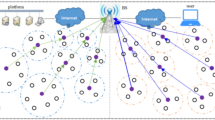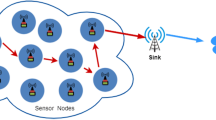Abstract
Wireless sensor networks are usually deployed in harsh environments, remote locations and unmanned areas. Especially in the complex application environment, the optimization of node deployment strategy is the basic problem of wireless sensor network research. An efficient node deployment strategy can not only significantly reduce the redundancy and deployment cost of network nodes, but also improve network awareness, robustness and lifetime by improving the energy efficiency of nodes and balancing the load of data traffic. It is particularly important to ensure the effective implementation of subsequent network monitoring tasks and the quality of service, which has become a research hotspot and key issue. Aiming at the problem of blind spots and node redundancy in network coverage, a sensor node deployment algorithm based on perceptual environment is proposed. The simulation results show that the deployment method can effectively cover the monitoring area and is suitable for various network application environments.







Similar content being viewed by others
Data Availability
The data used to support the findings of this research are available from the corresponding author upon request.
References
Jie, F., Hongbin, C., Xianjun, D., et al. (2021). Confident information coverage hole prediction and repairing for healthcare big data collection in large-scale hybrid wireless sensor networks. IEEE Internet of Things Journal, 8(23), 16801–16813.
Hongli, Y., Chih-Yung, C., Yajun, W., et al. (2021). CAERM: Coverage aware energy replenishment mechanism using mobile charger in wireless sensor networks. IEEE Sensors Journal, 21(20), 23682–23697.
Qiangyi, L., & Ningzhong, L. (2022). Monitoring area coverage based on improved virtual force and multimedia nodes movement data in mobile wireless sensor networks. Advances in Multimedia, 2022, 7121469.
Qiangyi, L., & Ningzhong, L. (2022). Monitoring area coverage based on control multimedia nodes position in mixed underwater mobile wireless sensor networks. Advances in Multimedia, 2022, 5888728.
Qiangyi, L., & Ningzhong, L. (2022). Coverage optimization algorithm based on control nodes position in wireless sensor networks. International Journal of Communication Systems, 35(5), e4599.
Qiangyi, L., & Ningzhong, L. (2021). Nodes deployment algorithm based on data fusion and evidence theory in wireless sensor networks. Wireless Personal Communications, 116(2), 1481–1492.
Qiangyi, L., & Ningzhong, L. (2020). Monitoring area coverage optimization algorithm based on nodes perceptual mathematical model in wireless sensor networks. Computer Communications, 155, 227–234.
Aparajita, C., & Debashis, D. (2021). Energy-efficient coverage optimization in wireless sensor networks based on Voronoi-Glowworm Swarm optimization-K-means algorithm. Ad Hoc Networks, 122, 102660.
Liu, C., & Hongwei, D. (2021). T, K-sweep coverage with mobile sensor nodes in wireless sensor networks. IEEE Internet of Things Journal, 8(18), 13888–13899.
Amutha, J., Jaiprakash, N., & Sandeep, S. (2021). A Distributed border surveillance (DBS) system for rectangular and circular region of interest with wireless sensor networks in shadowed environments. Wireless Personal Communications, 117(3), 2135–2155.
Reza, G., Ali, A., & Hosseini, A. S. M. (2021). Energy optimization of wireless visual sensor networks with the consideration of the desired target coverage. IEEE Transactions on Mobile Computing, 20(9), 2795–2807.
Ningning, W., Juwei, Z., Qiangyi, L., et al. (2014). Mobile nodes deployment scheme design based on perceived probability model in heterogeneous wireless sensor network. Journal of Robotics and Mechatronics, 26(5), 616–621.
Juwei, Z., Shiwei, L., Qiangyi, L., et al. (2014). Coverage hole recovery algorithm based on perceived probability in heterogeneous wireless sensor network. Journal of Computational Information Systems, 10(7), 2983–2990.
Peng, Z., Jianzhong, W., & Lingren, K. (2020). Construction and optimization of biconnected and wide-coverage topology based on node mobility. Symmetry-Basel, 12(5), 791.
Shahzad, A., Omar, A., Arshad, A., et al. (2020). Bodacious-instance coverage mechanism for wireless sensor network. Wireless Communications and Mobile Computing, 2020, 8833767.
Zijing, M., Shuangjuan, L., Longkun, G., et al. (2020). Energy-efficient non-linear K-barrier coverage in mobile sensor network. Computer Science and Information Systems, 17(3), 737–758.
Subash, H., & Pratyay, K. (2020). Coverage and connectivity aware critical target monitoring for wireless sensor networks: Novel NSGA-II-based approach. International Journal of Communication Systems, 33(4), e4212.
Binh, H. T. T., Hanh, N. T., Van Quan, L., et al. (2020). Metaheuristics for maximization of obstacles constrained area coverage in heterogeneous wireless sensor networks. Applied Soft Computing, 86, 105939.
Chuang, L., Hongwei, D., Qiang, Y., et al. (2020). Group sweep coverage with guaranteed approximation ratio. Theoretical Computer Science, 836, 1–15.
Mostafa, E.-H., Hanaa, Z. E., Hesham, A., et al. (2021). A fire detection model based on power-aware scheduling for IoT-sensors in smart cities with partial coverage. Journal of Ambient Intelligence and Humanized Computing, 12(2), 2629–2648.
Subash, H., & Pratyay, K. (2020). A novel NSGA-II for coverage and connectivity aware sensor node scheduling in industrial wireless sensor networks. Digital Signal Processing, 105, 102753.
Soni, V. U., & Namit, G. (2021). Wireless sensor network path optimization using sensor node coverage area calculation approach. Wireless Personal Communications, 116(1), 91–103.
Sheng-Chuan, W., Hsiao, H. C. W., Chun-Cheng, L., et al. (2022). Multi-objective wireless sensor network deployment problem with cooperative distance-based sensing coverage. Mobile Networks and Applications, 27(1), 3–14.
Jin, W., Gao, Y., Chang, Z., et al. (2020). Optimal Coverage multi-path scheduling scheme with multiple mobile sinks for WSNs. CMC-Computers Materials and Continua, 62(2), 695–711.
Chaya, S., & Jayasree, P. V. Y. (2021). Hybrid gravitational search algorithm based model for optimizing coverage and connectivity in wireless sensor networks. Journal of Ambient Intelligence and Humanized Computing, 12(2), 2835–2848.
Qiangyi, L., & Ningzhong, L. (2022). Monitoring area coverage based on adjusting nodes spacing in mixed underwater mobile wireless sensor networks. Wireless Communications and Mobile Computing, 2022, 5001662.
Qiangyi, L., & Ningzhong, L. (2022). Coverage blind area repair based on perceived multimedia data driven in mobile wireless sensor networks. Advances in Multimedia, 2022, 2354024.
Anamika, S., & Siddhartha, C. (2020). A distributed reinforcement learning based sensor node scheduling algorithm for coverage and connectivity maintenance in wireless sensor network. Wireless Networks, 26(6), 4411–4429.
Gia, N. T., Phan, T. V., Hoang, N. H., et al. (2020). An efficient distributed algorithm for target-coverage preservation in wireless sensor networks. Peer-To-Peer Networking and Applications, 14(2), 453–466.
Jiahao, X., Daozhi, W., Shucai, H., et al. (2019). A sensor deployment approach using improved virtual force algorithm based on area intensity for multisensor networks. Mathematical Problems in Engineering, 2019, 8015309.
Acknowledgements
The author gratefully acknowledges the helpful comments and suggestions of the editors and reviewers, which have improved the article.
Funding
The research is not supported by any funding.
Author information
Authors and Affiliations
Contributions
QL designed the research, analysed the data, and wrote the article.
Corresponding author
Ethics declarations
Conflict of interest
There is no conflict of interest in the research.
Human or animal right
Humans or Animals are not involved in the research.
Additional information
Publisher's Note
Springer Nature remains neutral with regard to jurisdictional claims in published maps and institutional affiliations.
Rights and permissions
Springer Nature or its licensor (e.g. a society or other partner) holds exclusive rights to this article under a publishing agreement with the author(s) or other rightsholder(s); author self-archiving of the accepted manuscript version of this article is solely governed by the terms of such publishing agreement and applicable law.
About this article
Cite this article
Liu, Y., Li, Q. Coverage Algorithm Based on Perceived Environment Around Nodes in Mobile Wireless Sensor Networks. Wireless Pers Commun 128, 2725–2740 (2023). https://doi.org/10.1007/s11277-022-10067-8
Accepted:
Published:
Issue Date:
DOI: https://doi.org/10.1007/s11277-022-10067-8




